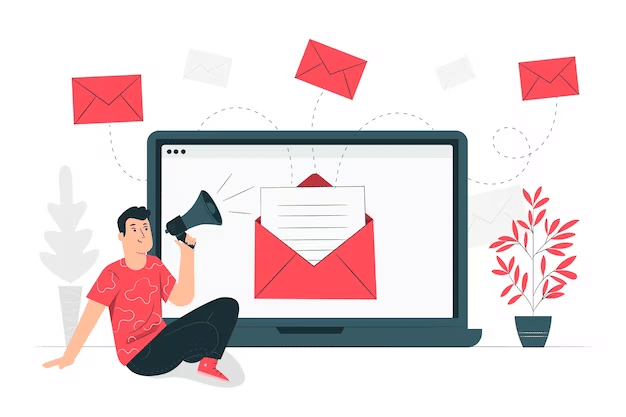
Email is undeniably an effective platform for lead generation. However, with users receiving over 40 emails daily, it’s getting harder to stand out in a crowded inbox. In fact, 61% of marketers say this is the biggest challenge they face in digital marketing.
So how do you get potential customers to fill out that all-important email opt-in form so you can start generating leads? The key is a well-crafted lead generation email marketing strategy.
In this article, we’ll explain how you can turn leads into paying customers with some top email lead-generation strategies.
What Is Email Lead Generation?
This type of lead generation involves using email marketing software to design, launch, and run marketing campaigns designed to generate leads for your business.
There are two main types of email lead generation:
- Inbound email lead generation: This type of email marketing involves attracting leads with a free yet valuable offer. Your target audience willingly gives you their details and permission to reach out to them with marketing material in exchange for your offer.
- Outbound email lead generation: This involves sending personalized cold emails to prospects that fit your customer profile. Unlike its inbound marketing, you don’t wait for leads to come to you. Instead, you contact them directly.
Why You Should Use Email Marketing Lead Generation
Filling your pipeline with sales leads is critical to your business’s success. But what makes email such an excellent lead-generation channel?
There are a few reasons:
✅ You can automate the entire process
You can easily set up, run, and manage email lead-generation campaigns on autopilot. This means less time and resources on your part.
✅ You can be highly specific with your targeting
Email is the best option when you want to target a specific audience. You can easily segment your list to ensure the right message reaches the appropriate audience. We’ll tell you more about audience segmentation later.
✅ It’s measurable
Another advantage of using email is that it’s easy to track and measure performance. This way, you’ll know what works and what doesn’t.
✅ Lead scoring is easy
Lead scoring is an essential aspect of lead generation that helps you drive conversions. It involves ranking your leads based on their quality and relevance and how likely they are to become paying customers.
Email service providers (ESPs) can give you the data you need to do this effectively.
✅ Lead qualification becomes simple
Qualifying your leads becomes easier thanks to the wealth of data you get from your email service provider and your customer relationship management (CRM) software.
In addition, you’ll be able to easily categorize your leads into different segments, such as marketing-qualified leads (MQLs) and sales-qualified leads (SQLs).
12 Email Lead Generation Strategies to Boost Conversions
For leads to turn into sales, you need a decent email response rate. Here are 12 email lead generation tactics to double your response rate and generate more engagement:
1. Hyper-personalization
Hyper-personalization is creating tailored experiences for each of your leads. This means creating unique, relevant messages across your marketing channels and assets, including:
- Landing pages.
- Images.
- Videos.
- Text.
Research shows that personalized emails enjoy higher open and click rates.
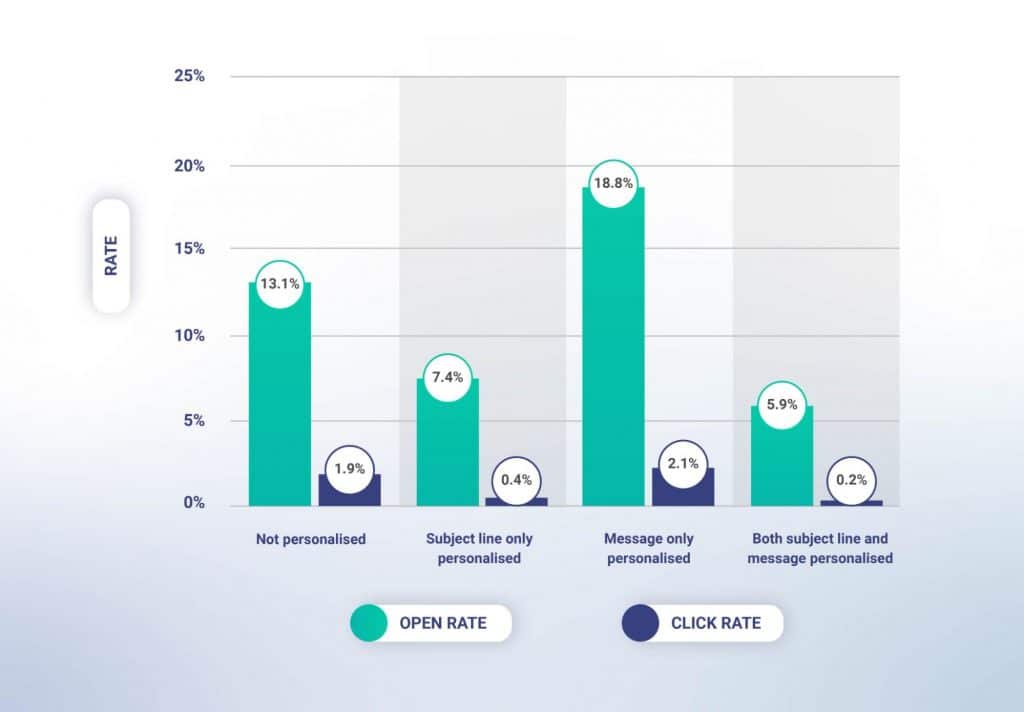
At Hyperise, we believe email personalization should go beyond using a lead’s name or job title.
Personalized images are vital in creating emotional connections with your customers. That’s why we’ve created a solution that allows you to personalize the text, images, GIFs, and videos in your emails.
Here’s an example of how the Hyperise editor was used to personalize a cold outreach lead generation email:
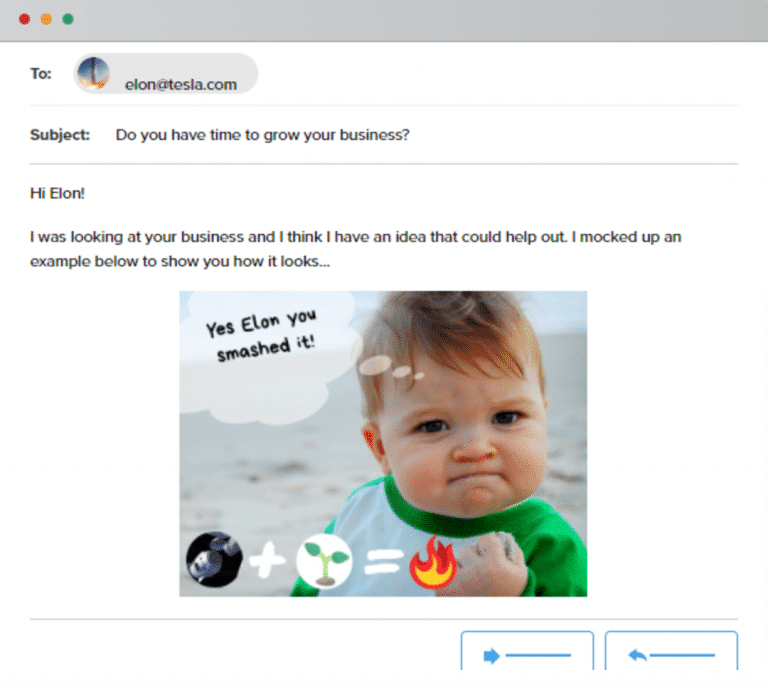
Generating more leads by using emails is a robust strategy. But it’s even more powerful if you hyper-personalize your messages.
2. Write about them first
To enhance your email lead generation, focus primarily on your audience rather than your product or yourself.
This is where conducting audience research and understanding your buyer personas or ideal customer profiles (ICPs) come in handy.
In-depth research on your customers will give you insights you can use to create valuable email content. Discover their pain points or aspirations so that you can create email content based on that data.
Once your readers know that you’re providing valuable content, they’ll likely engage more with your emails.
Now that you’ve focused on speaking to their pain points, you can start talking about your brand and how you can solve their problems.
3. Hook them with catchy, relevant headlines
Your subject lines are an essential element of a successful email lead-generation strategy. That’s because your subject line is the first part of your communication that your recipients see.
Here’s an example of an effective email subject line. It’s engaging and inspires curiosity, making the reader want to know more by opening the email:

The most effective subject lines evoke curiosity or inspire urgency. If you can pull off both, you’ve got a winning subject line.
An important part of a good subject line is personalization. Studies show that personalizing your subject lines can boost open rates by as much as 26%.
4. Write a strong introduction
Once your recipient opens your email, you have one chance to keep them engaged—your introduction.
Keep your introduction brief and include specific details about the recipient for personalized email content.
For example, if you know the name of the company they work for—or their job title—you could include this information in your introduction to show that you’ve gone the extra mile to get to know them.
5. Craft clean, crisp copy
The body of your email is also something worth paying attention to. Here are some tips:
➡️ Keep your message concise
Nobody has time to read through large walls of text in an email. Keep your copy short and simple.
➡️ Maintain a straightforward design
Use uncluttered templates that don’t distract the reader from your message. Be sure to use basic fonts, too, as they make your email more readable.
➡️ Make use of white space
Including a lot of white space in your email design makes it easier to read and more aesthetically pleasing.
6. Use emojis
Emojis have become a natural part of written communication in our world, and they’re an engaging way to communicate with your prospects.
Take a look at how an emoji was used cleverly in this subject line to grab the recipient’s attention:

However, you need to be careful with your use of emojis as you don’t want to overdo it.
So, how do you use emojis effectively in your email lead-generation campaigns?
- Use emojis in your subject lines and preview text to garner attention.
- Infuse emojis in your email copy to boost engagement.
However, you must ensure that the emojis you use align with your brand voice and fit the context of your email.
7. Include a clear call to action (CTA)
The main purpose of your lead generation email is to get people to take action. You want to send them further down your lead generation funnel by telling them where to go next.
You should never assume that your recipients know what you want them to do after reading your email.
That’s why every email you send must have a clear call to action. Here’s an example of a good CTA button in an email from GoDaddy:
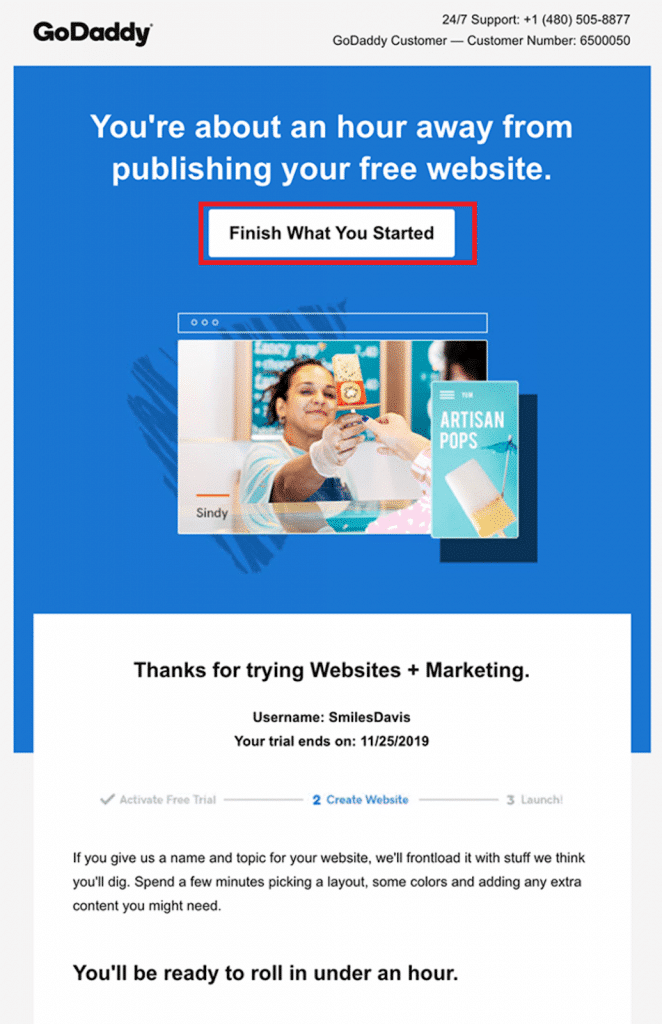
8. Inject humor into your emails
People respond better when they know there’s an actual human on the other end of the email.
One way to do that is through personalization. Another effective way of humanizing your brand and campaign is to tap into humor. This is an excellent way of engaging your readers and triggering positive emotions.

A few ways to use humor in your lead-generation emails include:
- Crafting funny subject lines.
- Using humorous memes and images.
- Injecting humor into your email copy.
- Driving more clicks with comedic CTAs.
It’s important to understand the demographics of the prospects you’re emailing before you use humor, as this may not be appropriate for some brands.
9. Leverage gated content
Another excellent way of driving leads through email is to create gated content for each stage of the buyer journey. This is content that people can only access after providing you with their contact details.
Here’s an example of gated content by 6Sense, formerly known as Appboy:
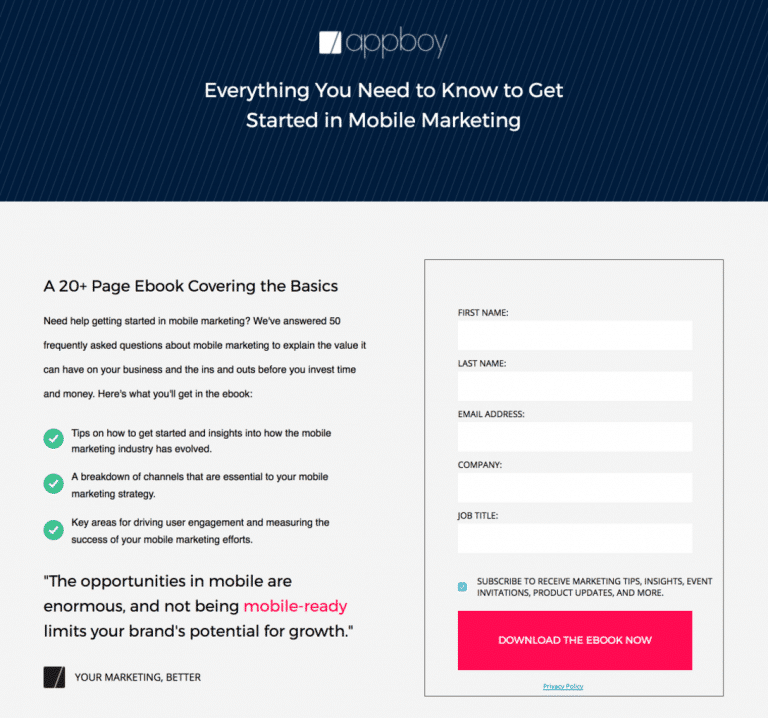
10. Use lead scoring
As mentioned earlier, lead scoring is an important tactic to include in your email lead-generation strategy.
As the name suggests, lead scoring is a system used to rank your leads according to their conversion potential or their level of interest in your business.
Lead scoring helps you understand how close your prospect is to becoming a paying customer.
How you score your leads is primarily up to the criteria you choose, meaning there’s no one-size-fits-all lead scoring system.
Examples of criteria you can use to score your leads include:
- Lead attributes: Their demographic data.
- Traffic source: Where your leads found your business.
- Engagement metrics: How they interacted with your website, landing page, emails, or other marketing assets.
A key reason to use lead scoring is that it removes the guesswork when prioritizing leads.
By focusing your attention, effort, and resources on leads that are more likely to convert, your conversion rate will naturally improve.
This is because lead scoring helps you craft tailored messages for your leads according to their lead score. It enables personalization in your interactions with your prospects, which can help to drive sales.
11. Perform a split test
Split testing (also known as A/B testing) involves comparing different aspects of your lead generation emails to determine which performs better.
It’s an excellent way of optimizing your copy, subject lines, and template designs, potentially resulting in higher engagement rates.
To effectively split test your emails and improve your conversion rates:
- Decide which elements to test.
- Determine your audience sample size.
- Design and run your test.
Ensure that you test only one element at a time to clearly identify which change enhances your campaign’s effectiveness.
12. Automate everything
Email lead generation campaigns have many moving parts that make them complex. Automation can help make things simpler.
A few benefits of automating your email lead generation include:
👍 Scalability
One of the most significant advantages of automation is that it allows you to scale your marketing efforts. As your business grows, your automation tools can scale with you.
👍 Effective personalization
Personalizing effectively, especially at scale, means that you need automation tools to help you get it right.
👍 Engagement increases
Automation increases engagement by allowing you to create customized journeys for your target audience.
Research shows that 80% of companies enjoy increased leads thanks to marketing automation.
Automation can increase both the quantity and quality of your leads.
How to Get Email Marketing for Lead Generation Right
With over 4 billion users, email is currently the most used communication channel, making it an effective lead-generation tool. But for it to work, you should design a strategy that drives results. Here are a few tips to help you:
📧 Use a reliable email service provider (ESP)
The success of your email lead generation depends largely on the ESP you choose.
An ESP should give you a variety of features and tools that allow you to store and manage contact information, segment your email list, and run automated email campaigns.
The right ESP will scale alongside your business with functions that can help you streamline your lead generation via this channel.
📧 Identify your target audience
Another crucial step in running an effective email lead-generation campaign is knowing who your target audience is.
Conduct in-depth research to gain as much insight as possible into your audience’s attributes and details.
This will help you create personalized experiences across your email campaign.
📧 Create an irresistible offer
To successfully get people to give you their email addresses, you must have an offer your audience will be willing to sign up for.
This offer, also called a lead magnet, must be designed to appeal to your ideal customers. It must also provide significant value.
Examples of lead magnets may include:
- eBooks or whitepapers.
- An email newsletter.
- Tools and calculators.
- Webinars.
- Free trials of a product.
- Case studies.
📧 Promote your offer
Once you’ve created your lead magnet, you need to get the word out. A few tips for doing this include promoting it:
- On your blog (in the blog posts or via a pop-up).
- Via social media.
- Using paid ads.
Getting your offer in front of the right people is critical to email lead generation, as it may increase your opt-in rate.
📧 Define your triggers and design your nurture campaign
In email lead generation, a trigger is defined as an action a person takes to set off the next part of your email campaign.
For instance, when someone opts into your email list by downloading your lead magnet, you should have a lead nurturing email sequence ready to be sent out one email at a time. This is a type of campaign that will help you:
- Build relationships with your leads.
- Educate them on your product.
- Earn their trust.
Your lead nurture sequence should be designed to make your audience feel that it’s all about them—not your brand or product.
📧 Segment your email list
At this point, you’ll want to segment your email list according to your new leads or how your recipients interact with your emails.
This will help you send relevant follow-up emails that are personalized, helping improve your response rate.
Most ESP tools will allow you to effectively segment your audiences into various groups to personalize your emails accordingly.
📧 Maintain your subscriber list
Not all potential leads will respond to your campaign. You don’t want to keep these contacts in your database. Instead, regularly maintain your email list and remove inactive subscribers.
Keeping them on your email list may compromise the quality of your campaigns.
The Best Email Lead Generation Software to Boost Your Strategy
As mentioned above, email lead generation works best when you automate. From managing your contact list to personalization and everything in between, you can use several lead-generation tools to your advantage.
Examples of some of the best marketing tools you can use to drive your lead-generation efforts include:
👉 Hyperise

Images are crucial for capturing attention, maintaining engagement with email leads, and improving response and conversion rates.
This is why you need personalization software like Hyperise in your lead generation toolbox.
With so many integrations available, you can use Hyperise with most of your other lead generation and marketing tools.
Beyond personalized images, you can also create custom GIFs, CTAs, videos, and text.
👉 Mailshake
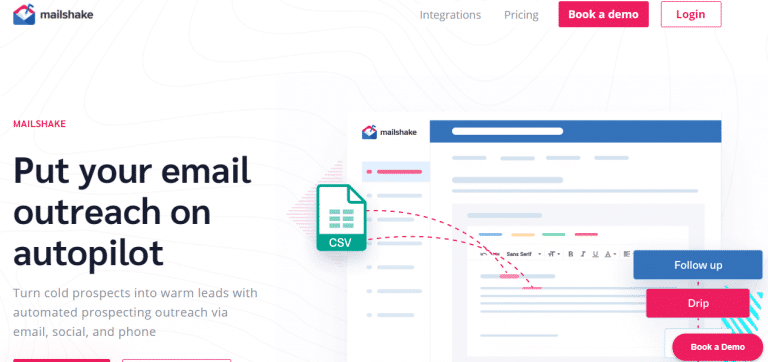
If you’re looking for an email automation solution that is simple and easy to use, try Mailshake.
It comes with a robust analytics dashboard, so you can easily track your campaign performance.
A tool like this also saves you time and resources as your email lead generation is entirely automated.
👉 SalesHandy

SalesHandy is another outreach email tool you should consider for email lead generation.
Trusted by big brands like Microsoft and Amazon, it comes with many useful features.
A few examples include mail merge, team collaboration, automated follow-ups, tracking, and in-depth analytics.
👉 Woodpecker
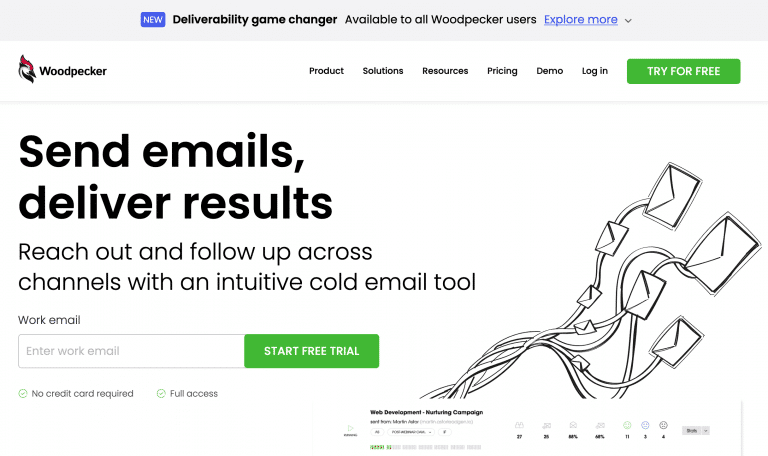
Designed with outreach email campaigns in mind, Woodpecker is packed with tools that help your emails drive engagement and get responses.
These are features like real-time email verification and validation, customizable snippets for personalization, and much more.
Generate Email Leads with the Best Personalization Tool
The people you are targeting with your lead generation emails likely receive a large number of emails each day. The challenge you face is trying to get noticed in a sea of messages.
One of the best ways to get people to open, read, and engage with your emails is to use personalization.
Personalization shows your email prospects that you’ve gone the extra mile to create content tailored to them and their specific needs. It helps to build trust and credibility, two essential ingredients when it comes to converting leads into sales.
It also helps your email stand out in a busy inbox.
With the Hyperise editor, you can create personalized images, GIFs, videos, text, and CTAs for your emails that help drive your prospects to take action and become paying customers.
Not convinced? Sign up for a free trial of Hyperise to experience first-hand how personalization can double your engagement and response rates.
Last Updated on April 30, 2024 by Ash